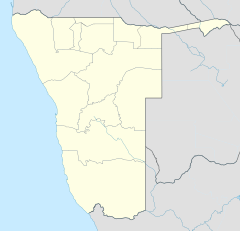South African Airways Flight 228
Coordinates: 22 ° 27 ′ 1 ″ S , 17 ° 31 ′ 26.5 ″ E
| Plane crash near Windhoek | |
|---|---|
|
A South African Airways Boeing 707-300 |
|
| Accident summary | |
| Accident type | CFIT after launch |
| place | 5 km east of JG Strijdom International Airport |
| date | April 20, 1968 |
| Fatalities | 123 |
| Survivors | 5 |
| Injured | 5 |
| Aircraft | |
| Aircraft type | Boeing 707-344C |
| operator | South African Airways |
| Mark | ZS-EUW |
| Surname | Pretoria |
| Departure airport | JG Strijdom International Airport, South West Africa |
| Destination airport | Luanda-4 de Fevereiro Airport , Angola |
| Passengers | 116 |
| crew | 12 |
| Lists of aviation accidents | |
Namibia |
The South African Airways Flight 228 was a flight of South African Airways with a Boeing 707-344C from Jan Smuts International Airport (now OR Tambo International Airport) in Johannesburg to London Heathrow Airport with scheduled stops in Windhoek , Luanda , Las Palmas and Frankfurt.
On April 20, 1968, shortly after take-off, the Boeing 707 crashed five kilometers east of "JG Strijdom International Airport", today's Hosea Kutako International Airport , 45 kilometers east of the Namibian capital Windhoek. In the accident , 123 people were killed and five injured were rescued.
Course of the accident
At 8:49 p.m. local time ( South Africa Standard Time ), the Boeing 707-344C aircraft , almost brand new with only 238 total flight hours , took off from runway 08 at the airport near Windhoek. The night was moonless and cloudless and there was no wind. After retracting the landing flaps and reducing the engine thrust to climb power at a height of about 200 m, the machine went into a - probably unnoticed - descent and hit about five kilometers east of the airport, almost 60 seconds after take-off.
Cause of accident
Due to the fact that the aircraft involved in the accident had neither a flight recorder nor a voice recorder , it was difficult to investigate the cause of the accident. Although flight recorders had become mandatory on January 1 of the year of the accident, many of South African Airways' planes were not equipped with them at the time due to delivery bottlenecks.
The pilot-in-command Smith had a flight experience of 4608 flight hours on the Boeing 707, but had only completed one flight hour on the 344C before the accident. The official accident investigation showed that all four engines of the machine were working. The cause of the accident was obviously human error , since the pilot and the first officer “did not ensure a safe airspeed and altitude and did not ensure a suitable climb because they did not observe the flight instruments sufficiently during the take-off phase”. The third person in the cockpit was expressly not at fault.
Web links
Individual evidence
- ^ Accident report B-707 ZS-EUW , Aviation Safety Network (English), accessed on January 30, 2019.
- ↑ a b c d Report by the Board of Inquiry into the Accident to South African Airways Boeing 707-344C Aircraft ZS-EUW at Windhoek on April 20. Civil Aviation Association, Pretoria November 1968 (PDF; 14.6 MB)
- ↑ Vic Alhadeff: A newspaper history of South Africa. 1984 edition, p. 112, ISBN 1-86806-008-X ( limited preview in Google book search)
- ↑ Aerospace Medicine , Issue 44, Issue 5-8, 1973, p. 683 ( limited preview in Google book search)
- ^ A b Edgar A. Haine: Disaster in the Air. , Associated University Presses 2000, ISBN 0-8453-4777-2 ( preview in Google Book Search)

